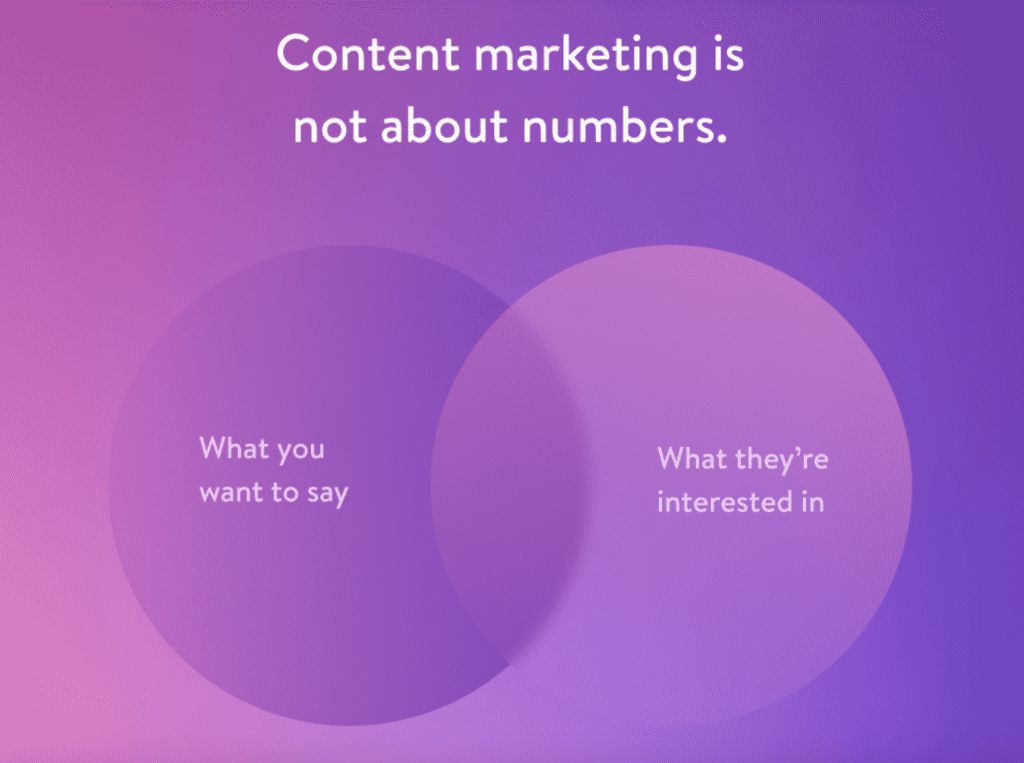Recently, our CEO and founder Shama Hyder spoke at SXSW Interactive.
Her topic? Lies that marketers believe.
What lies are you falling for?
Let’s dig in!
Attention is everything.
We’re taught early on that attention is key—that if our brands can just get more attention, more awareness, then our business will grow.
But attention isn’t everything. You can get attention for all kinds of reasons—plenty of which won’t help your brand grow long-term. Think of all the brands that get tons of attention for a moment or two, for something like a viral tweet or a really good video. How many of them are able to turn that attention into sustained growth?
Not very many.
What does lead to sustained growth? Relevance.
Relevance, in terms of B2B marketing at least, is a combination of:
- What your brand has to say
- What your audience wants to know about.

So as you’re developing your next digital campaign or piece of content, make sure you’re seeking the right thing.
Everything is trackable.
With all the data available today, many marketers have fallen into—or been forced into—a situation with their brand’s leadership in which every decision they make must be backed up with numbers.
There’s a certain logic to this, of course.
People like to be able to track or prove their efforts.
There’s been a massive shift toward quantifying everything as the digital marketing landscape has evolved. But just because it’s possible doesn’t mean it’s effective. A lot of this push has come from attribution software companies that need to sell their products, and the way they do that is to show brands their numbers. The numbers are supposed to prove the products work, right?
However, the thing that this obsession with tracking doesn’t take into account is dark social. Dark social refers to conversations that take place in private channels—such as Slack, private messaging apps like WhatsApp, closed LinkedIn or Facebook groups, etc.
These conversations are where the action is happening. Colleagues are recommending vendors to each other. Reviews are being shared. B2B buyers are interacting with and sharing content, and experiencing multiple touchpoints with brands, all on dark social.
Buying is a linear journey.
This is an interesting one.
Even though the marketing industry has nominally accepted that buying is not a linear journey, many marketers (or their CEOs) still treat it as one.
The idea—or the lie—here is that someone sees your brand, interacts with your content, checks out your product, talks to a salesperson, and then decides to buy or not buy. Then it’s time to start all over again with another buyer.
But this isn’t how it works anymore. Instead, there’s something Google calls the “messy middle”. This is where a customer’s independent research, dark social conversations, and interactions with your content—in other words, the stuff you can’t identify or track or know about—comes together. And more often than not, this is where the buyer decides to make a purchase.
Related reading: How To Make Dark Funnel Marketing Work For You
If you can truly embrace and accept that the buyer journey is not linear (and maybe not even circular), then you’ll be much better at identifying the opportunities that can actually move the needle for your prospects.
PR, for example, is an ideal tool for getting at this messy middle because it increases your share of voice overall, giving your prospects and customers more places to find you—and, therefore, more opportunities for touchpoints.
CTRs are a good metric.
As convenient as the click-through rate is for marketers to measure, it isn’t actually a reliable indicator of success or failure.
So why has it been held up as such a critical KPI?
There are a couple of reasons—but the simplest one is that it’s easy. You can see your click-through rate on any analytics program and quickly draw conclusions: a higher number means a high rate of success, and a lower number means a low one. Right?
Related reading: Why Click-Through Rate Doesn’t Matter, and the KPIs Brand Marketers Should Actually Care About
That’s not actually true. In fact, CTRs have a negative correlation with brand recall, brand awareness, and customer intent. There have even been studies performed to see whether more people will click on a brand ad or a solid black banner. Can you guess which one gets more clicks?
It’s the black banner.
This all makes sense given what we know about people—not as customers, but as fellow humans who use the internet. How often do you see an ad you just can’t wait to click on? And when you do click, is it because you actually want the product, or because you’re just curious?
That doesn’t mean that performance marketing and paid ads don’t have a place in marketing. They do—but measuring success by looking at click-through rates is neither meaningful nor is it accurate.
Loyalty is more important than acquisition.
For many brands, keeping a current customer is more important, overall, than gaining a new one.
The numbers back this up. It has been proven to be between 5 and 25 times more expensive to gain a new customer than to keep a current one. And brands that continually gain new customers but can’t keep them won’t be able to grow or sustain.
However, as with all things in life, there is some nuance. The only brands that can afford to put the majority of their efforts into loyalty over acquisition are the ones that already have the lion’s share of the market.
This is because the only way to grow your brand loyalty is to increase your acquisition to the point that you become a brand leader. Another way to say this: if you put your emphasis on acquisition, it automatically leads to loyalty.
Related reading: Acquisition or Retention? The Results Are In: B2B Marketers Need to Focus On New
This is not to say that you should forego customer loyalty marketing completely. It has an important place in your overall marketing strategy (and your sales department should be involved in this, too).
But take a realistic look at where your brand is before you start divvying up your marketing efforts. If you’re not at the head of the pack, devote the resources necessary to getting enough customers so that you do pull to the front.
It’s time to let go of these lies that are holding your marketing back and focus on what actually works in today’s digitally-native, online world. It’s difficult to forego the measurable in favor of the meaningful, but it’s the only way to grow your business.
Want to hear more about Shama’s experience at SXSW? Read about it here. If you need some help figuring out what these lies mean for your strategy, give our team a call.





